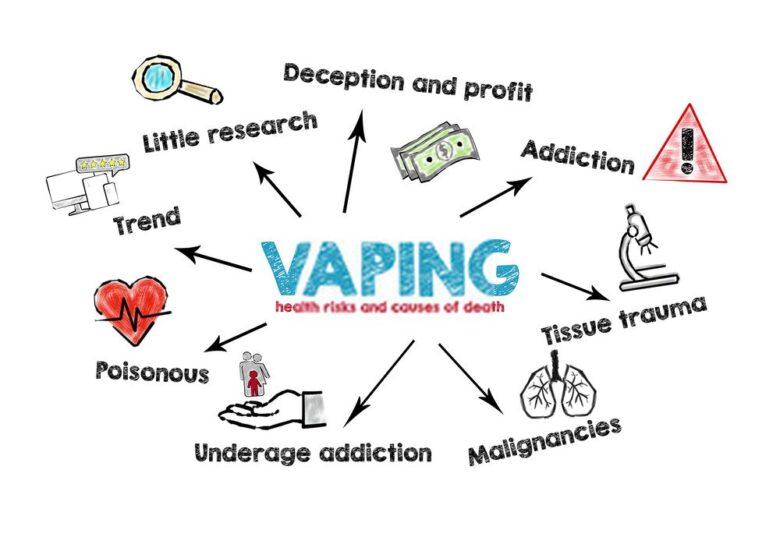The faint whirring of vape devices has become an unsettling soundtrack in the lives of many school administrators, parents, and health professionals. The phenomenon of vaping, once considered a less harmful alternative to smoking, has evolved into a pervasive and concerning addiction among school-aged children. The urgency to address this issue is palpable as the prevalence of vaping continues to rise, casting a shadow over the health and well-being of our youth.
The Health Implications of Vaping

As the sweet scent of flavored vapors drifts through school hallways, the insidious health risks associated with vaping remain less evident. However, these risks are very real and need to be acknowledged. It poses a threat to young lungs, with serious respiratory issues becoming more commonplace. Moreover, the allure of flavored e-cigarettes conceals a sinister fact: nicotine addiction. The adolescent brain is especially vulnerable to nicotine’s grasp, leading to cognitive and behavioral disruptions. Recognizing the gravity of these health implications is the first step in curbing vaping’s allure.
Schools’ Strategies to Curb Vaping Addiction
The battle against vaping addiction starts with arming students with knowledge. Schools are taking the initiative by implementing comprehensive awareness campaigns that equip students with the facts they need to make informed decisions. Workshops and presentations by guest speakers are common tools in this arsenal, utilizing personal stories and medical insights to drive home the dangers of this activity. Curriculum adjustments also play a pivotal role, weaving vaping education into subjects like health, science, and even literature, making it impossible for students to escape the critical information.
Schools, Parents, and Communities Unite Against Vaping
Recognizing that tackling vaping addiction is a shared responsibility, schools are fostering parental involvement. Regular parent-teacher meetings have transformed into opportunities for discussions about potential risks. Informative sessions equip parents with the language and knowledge needed to address the issue at home. Schools are also providing resources, from informational pamphlets to digital guides, to bridge the information gap and facilitate productive conversations.
Community Partnerships

Understanding that schools alone cannot dismantle the vaping epidemic, collaborative efforts with local organizations are making waves. Workshops and community events act as platforms to amplify anti-vaping messages. By enlisting the support of medical professionals, law enforcement, and other influential community figures, schools are creating a united front against this addiction that resonates beyond the classroom walls.
Creating Vape-Free Environments
Clear policies are the backbone of a vape-free environment. Schools are taking a no-tolerance stance on vaping, outlining severe consequences for violations. These policies are meticulously communicated to students, parents, and staff, leaving no room for ambiguity. Vigilant enforcement methods, including random checks and thorough searches, are in place to ensure compliance. By establishing an environment where it is unequivocally unacceptable, schools are setting the stage for change. In addition to policies schools should be equipped with a vape detector such you can find here and prevent this activity in its root.
Empowering Student Leaders
Recognizing the influence of peers, schools are tapping into the power of student leadership. Student ambassador programs empower motivated individuals to spearhead anti-vaping campaigns. These leaders receive specialized training to effectively communicate the dangers of this activity to their peers. Through engaging initiatives, such as interactive presentations and creative awareness drives, student ambassadors are igniting a grassroots movement against vaping addiction.
Incorporating Health Education Curricula

To weave anti-vaping messages into the fabric of student understanding, schools are embedding vaping-related content into health education curricula. Interactive lessons that present real-life case studies highlight the tangible consequences of this activity. Engaging classroom discussions facilitate critical thinking and empower students to make informed decisions about their health.
Using Technology to Fight Vaping
In a digital age, technology serves as a powerful ally in the fight against vaping addiction. Educational apps are designed to captivate students’ attention while educating them about risks and consequences. Through interactive features and quizzes, these apps engage students in an exploration of the topic, demystifying the allure of vaping and reinforcing the knowledge necessary to resist it.
Counseling and Support
Breaking free from vaping addiction isn’t just a physical battle—it’s an emotional and psychological one too. Schools recognize this and are offering specialized counseling services tailored to this addiction. Trained counselors provide a safe space for students to navigate their addiction, offering individual and group therapy sessions. Confidential support ensures that students receive the assistance they need without fear of judgment.
The Role of Legislative Measures

Schools are extending their influence beyond their immediate communities by advocating for stricter regulations on vaping products. Letter-writing campaigns, petitions, and collaborations with policymakers amplify their collective voice, urging for legislative action to curb vaping’s allure. By aligning with public health initiatives, schools are shaping a future where it is not just discouraged but is genuinely difficult to access for underage individuals.
Monitoring and Early Intervention
Early intervention is a cornerstone of effective addiction prevention. Schools are implementing risk assessment programs to identify students who may be at risk of falling into this addiction. Observation, communication with teachers, and counseling referrals form a comprehensive approach to identifying and supporting vulnerable students before the grip of addiction takes hold.
Measuring Success
Amidst these multifaceted efforts, the ability to measure success becomes crucial. Schools are employing various data collection methods to track vaping incidents and trends. Surveys and focus groups gauge the impact of anti-vaping initiatives, helping schools refine their strategies. Collaborations with health agencies also provide a broader perspective, ensuring that interventions remain effective and responsive to evolving circumstances.
A Long-Term Commitment

The fight against vaping addiction is not a one-off endeavor but a sustained commitment. Schools are working to integrate anti-vaping messages into their cultural fabric. Ongoing campaigns, reminders, and events serve as constant reinforcements of the anti-vaping message. By fostering a culture that prizes health and well-being, schools are equipping students with the tools they need to resist the allure of this activity.
Conclusion
The battle against vaping addiction among students is complex, but schools are proving to be formidable allies in this fight. Through comprehensive education, collaboration, policy implementation, student empowerment, and a holistic approach, schools are stepping up to address this pressing issue head-on. By continually evaluating their efforts and adapting their strategies, schools are helping students make informed decisions that pave the way for healthier futures, free from the shackles of this addiction.

